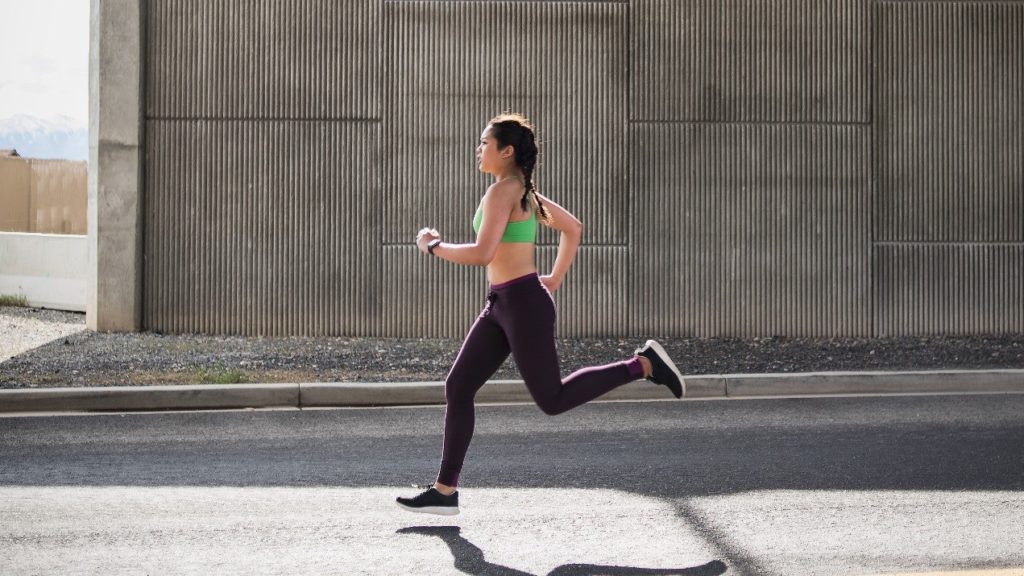
The Fit Woman’s Guide to Body Fat
Get access to everything we publish when you
sign up for Outside+.
Your jeans are looser than ever, you’re hearing compliments about your buff arms and you’re seeing muscles in new places. But the scale hasn’t budged and your body mass index, or BMI, suddenly places you in the overweight category. What gives?
BMI Is Not a Body-Fat Calculator
The BMI formula — a simple calculation based on your height and weight — has been around since the mid-1800s, but only in the last few decades has it gained popularity among doctors as a way to estimate a healthy bodyweight and mortality risks. Anything below 18.5 is considered “underweight,” 18.5 to 24.9 is “normal,” 25 to 30 is “overweight,” and 30.1 or more falls into one of three obesity categories.
But as Nancy Clark, MS, RD, FACSM, a Boston-based sports nutritionist and author of Nancy Clark’s Sports Nutrition Guidebook (Human Kinetics, 2013), points out, the BMI doesn’t distinguish between fat and muscle, and it only gives you an indication of how heavy you are overall. “It’s a very poor model for active people,” she says.
In his prime, Arnold Schwarzenegger had a whopping BMI of 30.2 — “obese” according to the calculation. But anyone who’s seen “Arnie” at his best knows that he was all lean muscle, not fat.
On the flip side, research shows that BMI also can be a false indicator of health in other ways. According to the American College of Cardiology, researchers presented their findings, which showed that individuals with a normal BMI can still have a high body-fat content, increasing their risk for cardiovascular disease and other health-related problems.
BMI: Stop Believing the Lie
“Tracking weight and BMI are not great tools to measure progress because as body composition changes, the scale may not,” explains Dave Quevedo, a NASM-certified personal trainer in Hoboken, New Jersey. “Both weight and BMI never take into account body composition, often making an active woman seem overweight — but an active woman has more muscle and less body fat than a sedentary woman.”
Because muscle is denser than fat, it takes up less space on your frame. Quevedo says to look at it this way: If you weigh an equal volume of fat and muscle, you’d be surprised that the muscle weighs almost twice as much as the fat. As you advance in your training and gain more lean muscle mass, the spikes in your weight and BMI are signs of progress — not reasons to lose motivation.
That certainly holds true for Stephanie Mansour, a certified personal trainer, yoga and Pilates instructor, and women’s weight-loss coach. “I am on the higher end of the BMI scale,” she says. “In fact, many of my private weight-loss clients are shocked when they hear my weight. It may sound high, but since I work out regularly, I have a lot of muscle on my body. Athletes, bodybuilders and those who strength-train regularly often have higher BMIs. And that’s why I personally don’t worry about my BMI.”
So if this sounds like you, too, relax. Ignore the BMI lies and take a different approach to determining your body-fat percentage than your less-fit friends.
What Factors Falsely Affect Your BMI and Scale Reading?
To add insult to injury, there are many reasons your scale or BMI are not even providing you with accurate results. Mansour says these could include the following:
- Water weight. If you’ve been flying recently, you could be holding onto extra fluid that’s weighing you down.
- Constipation. Sometimes things get bottlenecked inside our guts — wait for them to pass before stepping on the scale.
- Sodium. Eating foods high in sodium will definitely impact your readings.
- Hormones. If it’s a few days before your period, your scale will show hormonal weight fluctuations.
So can we all agree to ignore the BMI calculator when trying to accurately determine your body-fat percentage?

6 Other Ways to Tell if You’re Progressing
Now that BMI is out the window, how else can you tell if you’re making progress in your body composition? Look at other factors in your life, including the following:
- More energy. If you wake up in the morning, and instead of feeling sluggish, you feel energized and ready to tackle the day, Mansour says that things are pointing in the right direction.
- Better mood. “Are you less moody, less anxious, feel less depressed, feel happier and have a more positive outlook on life?” Mansour asks. “This can be a result of eating healthier foods, exercising more and taking better care of yourself.”
- Regularity. When your digestive tract is working more efficiently, you’re able to eliminate waste regularly.
- Increased focus. Feeling sharper, focused and more alert is another sign Mansour suggests using as a clue to improved health.
- More control. “If you’re having less emotional eating instances or cravings, then you’re likely regulating your blood sugar levels by eating better foods,” Mansour says. “Therefore, you’ll have less cravings, less binges and less emotional eating.”
- You crave water. Bet you never thought you’d be choosing water over soda or coffee, right? Water helps cleanse and detoxify the body — when you’re thirsty or used to drinking more water, Mansour says this is a sign that your body is working more efficiently.
The Location of Your Body Fat Matters
When you begin a new fitness program or increase the intensity of your sessions in the gym, chances are you’re losing fat but gaining muscle, says Fabio Comana, MS, exercise physiologist with the American Council on Exercise. And, as you know, muscle beats fat for many reasons.
“Muscle uses more calories, even at rest, so you gain the potential to boost your resting metabolic rate,” says Janet Walberg Rankin, Ph.D., a professor in the Department of Human Nutrition, Foods and Exercise at Virginia Tech. “And muscles help us perform better, if we’re competing or just want to be able to last through our workout or exercise class.”
You shouldn’t ditch measurements altogether, however. Instead, sports nutritionists and trainers urge active women to consider where their fat is stored. That’s because women can be “skinny fat,” appearing to be healthy based on weight and height alone but possessing pockets of fat in targeted areas that puts them at higher risk for certain health conditions.
Abdominal fat, for example, is increasingly linked to metabolic syndrome and heart disease. Women whose waists are 35 inches or more have a higher risk of health problems than those with smaller waists, no matter how much they weigh. And a Danish study in Circulation found that extra body fat in women’s hips can increase the risk of venous thromboembolism, or dangerous blood clots in the veins.
So it’s important to consider your overall body fat and where it might be landing. Though there’s no such thing as spot reduction, targeted training can help decrease your body fat and increase your muscle — leading to a leaner looking body. “Reducing your overall body fat through methods of resistance training and cardio are the best ways to change your body composition,” Quevedo says.
Brown Fat: A Healthy Body Fat?
Two studies in The New England Journal of Medicine about how a special form of thermogenically active fat tissue burns through excess energy suddenly caught the media’s attention. One headline even read: “Brown Fat: A Fat That Helps You Lose Weight?”
Read: Linking Brown Fat and Fat Loss
Well, sorry to burst your bubble on that theory. “Brown adipose fat, or BAT, is generally irrelevant,” Comana says. “Thousands of years ago, it helped keep us warm through the cold months.” But these days, we don’t need to survive the frigid weather — we have clothes, homes and heaters — so we’ve evolved away from brown fat. “For the most part, it’s hype,” he confirms.
Ideal Body-Fat Percentage for Women
New technology is improving the accuracy of overall body-fat measurements. Women seeking optimal fitness levels should aim for about 16 to 25 percent body fat, says Kathleen Laquale, Ph.D., athletic trainer at Bridgewater State College in Massachusetts. Though fitness competitors may aim for lower levels, anything below 15 percent simply can’t be sustained for the long term without health risks.
“You need at least 3 percent fat on your body just to live,” explains Laquale, who says that dropping below 15 percent for a long time could result in risking losing your period, developing osteoporosis and suffering general fatigue. “A body-fat percentage that’s too low can be harmful to your health and well-being.”
By now you may be wondering, “How much body fat should I have?” Check out the ranges in this healthy body-fat percentage chart, broken down by fitness level:
| Top Athletes | 15 to 20% |
| Fit Women | 21 to 24% |
| Healthy/Acceptable | 25 to 32% |
| Overweight | 33% plus |
How to Calculate Body Fat
If you’re ready to learn how to measure body fat at home or a professional institution, start with the list below. Simply choose the best body-fat calculator for your lifestyle and budget:
Cost: $15 to $400
Accuracy: Plus or minus 3% error; mostly measures fat just under the skin
Accessibility: Found at most fitness clubs
2. Body-Fat Scales for Home Use
Cost: $20 to $300 for a machine that determines body fatfrom the resistance to an electrical current
Accuracy: Plus or minus 3% error
Accessibility: Available online for purchase
3. Hydrostatic Testing (Underwater)
Cost: $15 to $50 per test
Accuracy: Plus or minus 1.5% error
Accessibility: Usually conducted at research institutions and universities

Non-Scale Victories
Scales, measuring tapes and technology are helpful in providing some information about your body-fat percentage, but it’s not the whole story. Some of the simplest techniques will further help map your success and boost your confidence as you shed fat, build muscle and get on the way to reaching all your goals.
“In fact, there’s a new movement called #screwthescale, where influencers and everyday people are taking before and after photos to show how much better they look and feel at a higher weight,” Mansour says. “They put on muscle, burned fat and, in most cases, got smaller bodies — but the point wasn’t about becoming smaller. It was about becoming healthier and showing how weightlifting and putting on pounds on the scale actually made them healthier.”
She says to get out of the bathroom and track your fit progress with these other reliable indicators of fat loss and muscle-building success:
- Your jeans. Are your clothes looser? Are they fitting better and more comfortably? Do you have more space in your waist? Are your jeans easier to button or zip? Are your thighs less squeezed in?
- Your sets and reps. Has your gym performance improved? Can you train longer, lift heavier or complete your exercises with more ease? Is your form getting better? Are you feeling more in sync with your body? Are you looking forward to your gym sessions?
- Your daily tasks. Are you finding it easier to carry all 10 bags of groceries from the car? Is it easier to shovel the snow in the winter? Are you less winded from climbing stairs?
- Your energy levels. Do you find yourself less exhausted and more pumped when you first wake up? Are you feeling less tired during the midafternoon slump? Are you less exhausted throughout the day? Are you ready to go to bed in the evenings? Has your sleep schedule become more regular?
- Your reflection. How do you appear in the mirror — jiggly all over or firm in parts? In the mirror when you flex your arms and legs, can you see more muscle and definition?
5 Essentials to Reach a Healthy Body-Fat Percentage
Keep your body fat in check with these Oxygen-approved strategies:
- Strength-train. Adding weights into your routine not only makes you stronger and leaner but also increases your metabolism and helps you burn more fat.
- Eat clean foods. Make sure your diet is well-rounded, with vegetables, fruits, high-quality meats, beans and whole grains.
- Don’t forget the cardio. Try adding one-minute intervals into your program to up your energy and blast fat.
- Eat more frequently. Plan five to six meals a day instead of three large ones, and never skip breakfast.
- Be patient. Quick results usually don’t last, so go with the slow-and-steady approach to reach your goals and stay lean.
“A holistic approach to health includes one that takes into account your physical and mental well-being,” Mansour says. “If you’re following a set plan to lose weight or body fat, how do you mentally feel about the plan and what you’re doing? Instead of being so focused on checking off things on a list, remember that every single one of our bodies is different and responds differently to different things. Be willing to course-correct and be willing to not always follow the plan perfectly. By integrating healthy habits into your everyday life, they’re more likely to stick over the long term.”
Published at Wed, 19 Jan 2022 05:09:07 -0800






